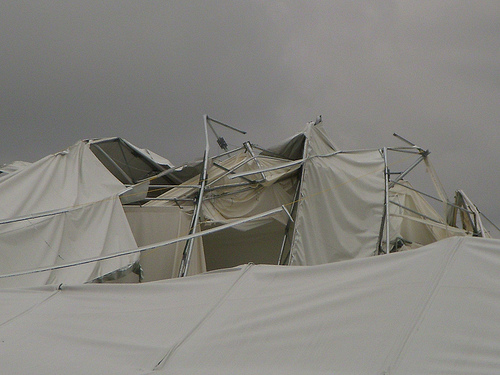 The story of the collapse of the Dallas Cowboys practice facility continues to point towards serious design flaws as the culprit. The National Institute of Standards and Technology press release regarding its report states that the practice facility collapsed, “under wind loads significantly less than those required under applicable design standards”. A full copy of the draft NIST report and accompanying slideshow are quite interesting. The design and construction firm involved in the project has consistently claimed that severe weather conditions were to blame; however, the NIST report expressly concluded that wind speeds at the time of collapse were well below design loads and further that the demands at code required wind loads exceeded the structure capacity of the facility.
The story of the collapse of the Dallas Cowboys practice facility continues to point towards serious design flaws as the culprit. The National Institute of Standards and Technology press release regarding its report states that the practice facility collapsed, “under wind loads significantly less than those required under applicable design standards”. A full copy of the draft NIST report and accompanying slideshow are quite interesting. The design and construction firm involved in the project has consistently claimed that severe weather conditions were to blame; however, the NIST report expressly concluded that wind speeds at the time of collapse were well below design loads and further that the demands at code required wind loads exceeded the structure capacity of the facility.
The practice facility was a steel frame structure with a tensioned fabric covering. The practice facility collapsed on May 2, 2009 during a windstorm. Twelve people were injured in the collapse, which left a scouting assistant permanently paralyzed and broke the neck of a special teams coach. The video report embedded with this post includes some harrowing footage prior to and during the collapse.
The factual backdrop of this disaster is fairly remarkable in the rapid and extensive dirt exposed relative to the project. As seen from the timeline prepared by The Dallas Morning News (this and the other links are free, sign-up is required), Cover-All Building Systems and its subsidiary, Summit Structures, designed and built the Cowboys practice facility. Cover-all suffered a warehouse collapse in Philadelphia that the Cowboys were aware of prior to hiring Cover-all for the practice facility project in 2003.
Reports following the filing of suit on the Cowboy practice facility matter have pointed to far deeper problems. It appears that the person who handled initial structural calculations on both the Philadelphia and the Cowboys’ facility was a trainee and unlicensed. Cover-all fired the engineering director of the Philadelphia and Cowboys facility projects. The person identified as the lead engineer of the project stated he had little to do with the project, worked for Summit only briefly, and had been hired to build small farm buildings. After the completion of the Cowboys’ project, the engineering director’s successor warned Cover-all management in 2004, “We can’t continue to operate this way or we’re going to kill somebody.”
The Philadelphia collapse eventually resulted in a very large verdict against Cover-all. The Cowboys expressed some concerns regarding their facility and Cover-all eventual reinforced the facility roof, but that obviously was not sufficient to stave off the collapse.
There are a couple takeaways from this horrible event:
- Follow your instincts – if you are worried about your designer or contractor, there are probably good reasons
- Follow up on licenses, codes and inspections – reports indicate that permits were not pulled for the 2008 retrofit work as required
- Get second opinions when reasonable and required
- Know the qualifications and background of key personnel
- Don’t assume
- To quote both my wife and Ronald Reagan, Trust but Verify!!
Image: Copyright Silver Smith, 2009

